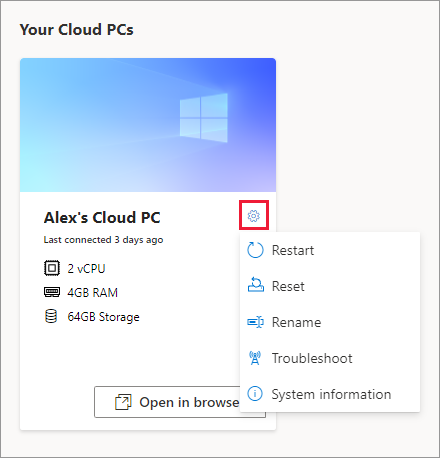Explore Windows 365
Windows 365 is a cloud-based service that automatically creates a new type of Windows virtual machine (Cloud PCs) for your end users. Each Cloud PC is assigned to an individual user and is their dedicated Windows device.
Windows 365 is available in two editions:
- Windows 365 Business: Windows 365 Business is made specifically for use in smaller companies (up to 300 seats) who want ready-to-use Cloud PCs with simple management options. There are no licensing prerequisites to set up Windows 365 Business. There are no dependencies on Azure or Active Directory. Purchases are made through the Microsoft 365 admin center or the Windows 365 product site.
- Windows 365 Enterprise: Windows 365 Enterprise is for larger companies who want unlimited seats for creating Cloud PCs. It includes options to create custom Cloud PCs based on your created device images, more management options, and full integration with Microsoft Endpoint Manager. It leverages Microsoft Entra ID and AD DS domains.
Windows 365 versus Azure Virtual Desktop
Windows 365 and Azure Virtual Desktop are built on the same platform. On the backend, the functionality is essentially the same. The key difference is how they're provisioned and managed. The following table is a general comparison between the two solutions:
Windows 365 Enterprise
Azure Virtual Desktop
VMs manged by Microsoft
VM managed by organization
Easier to set up
Requires Azure administration skills
Managed through Endpoint Manager admin center
Managed through Azure portal
Assigned to individual users
Individual or pooled desktops
Fixed per-user/per-month cost
Cost based on Azure usage
Profiles are stored in the VM instance
Uses FSLogix storage solution
While setting up AVD has more complexity, it provides the most flexibility because the customer is managing the VMs. However, not all customers need the level of flexibility that AVD provides. In Windows 365, Microsoft manages the VMs, providing a relatively simple solution with enough flexibility for many organizations. An organization that prefers pooled desktops may deploy or continue to use AVD. Organizations that typically want to assign persistent cloud PCs to users may choose to deploy or migrate to Windows 365.
Access cloud PCs
Users can navigate to https://windows365.microsoft.com to access their Cloud PCs, connecting through Remote Desktop.

The Remote Desktop client is available for Windows, macOS, iOS/iPadOS and Android.